#The specific species is the false gharial
Explore tagged Tumblr posts
Text
Original Source: Greg Lasley
Original Source: Praisaeng
Original Source: NajaShots
Original Source: Toronto Zoo
Original Source: Jakob Fahr
Original Source: Toronto Zoo
Original Source: Gerard Lacz
Original Source: Rainer Traxl
we're sleeping on how varied crocodilians are in colour and pattern
Yacare caiman

Tomistoma
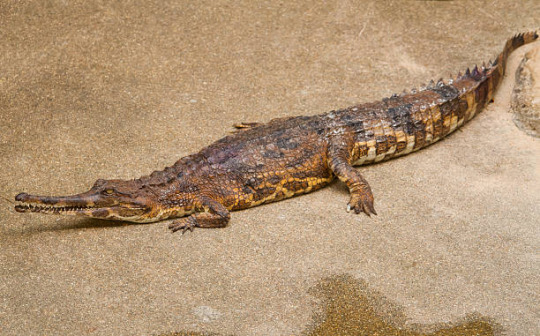
Cuban crocodile
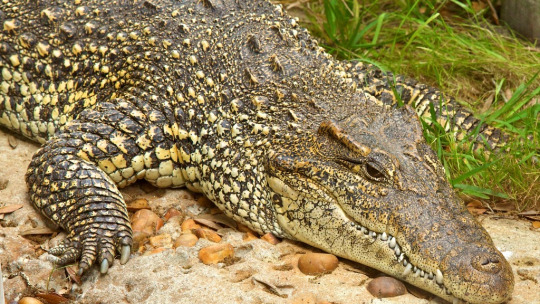
Cuvier's dwarf caiman

West African crocodile

American alligator

Saltwater crocodile

New Guinea crocodile
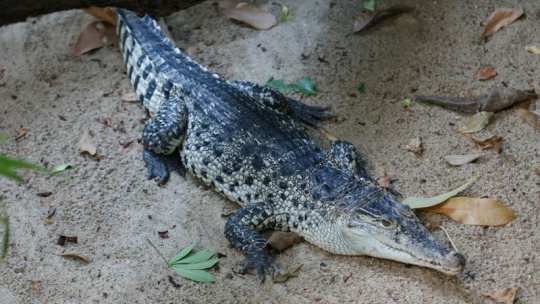
#Long Post#Original Source Found#Also “Tomistoma” isn't a species of crocodilian that's the genus name#The specific species is the false gharial
2K notes
·
View notes
Text
Croc colours and patterns
Somewhat inspired by a recent post by Joschua Knüppe, I feel like it's a good thing to remind people just how diverse colours and patterns in modern crocodilians are. When I see people make art, it often seems to stick to grey or yellowish-brown tones, which is of course not incorrect. But theres a lot of, imo, underappreciated variety still. It's also worth noting beforehand that patterns are most striking in younger individuals and naturally become more muddy the older and larger an animal becomes. But as you will see, even some decently large and old animals may maintain a striking appearance.
Take this alligator for example. Gators tend to be on the darker side, dark greys to black, sometimes countershaded and sometimes pretty consistent. Some individuals, like this one photographed by Gar Luc, still retain clearly visible stripe patterns from when they are younger.
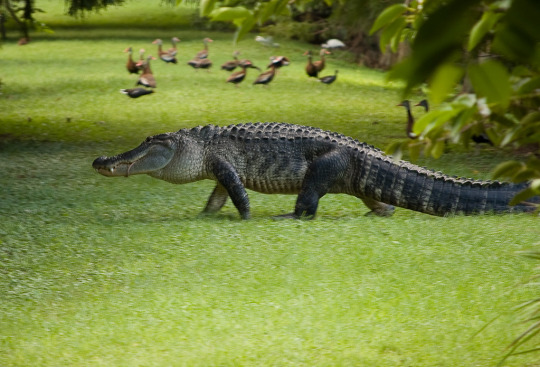
Or take one of my favourite species, the Cuban Crocodile, which can appear almost bright yellow with a dense pattern of leopard spots. Of course like with the gator you can find individuals that are much more drab, with washed out colours, but individuals with clearly defined patterns still exist.

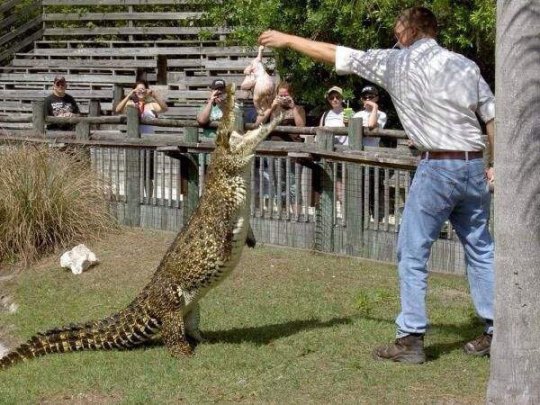
Then there's gharials of course. They can range quite a bit in colouration. They can be brown, especially younger ones and females and I've seen males range in colour from a drab grey to almost a light blue or even something that could be described as metalic black.
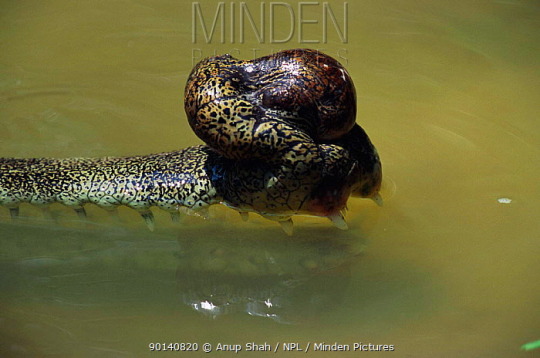
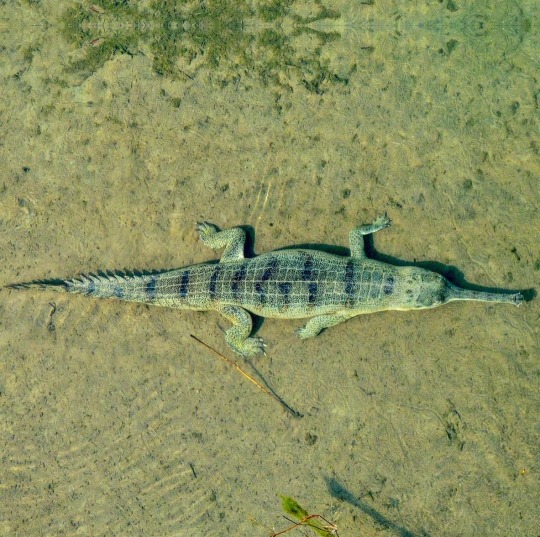
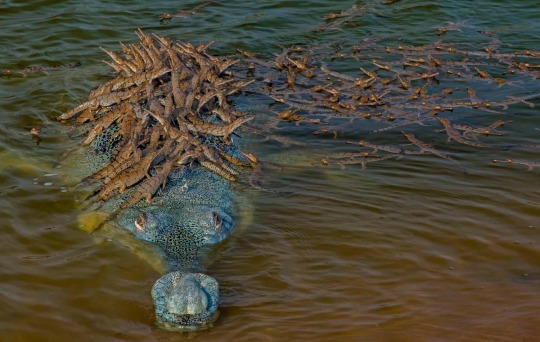
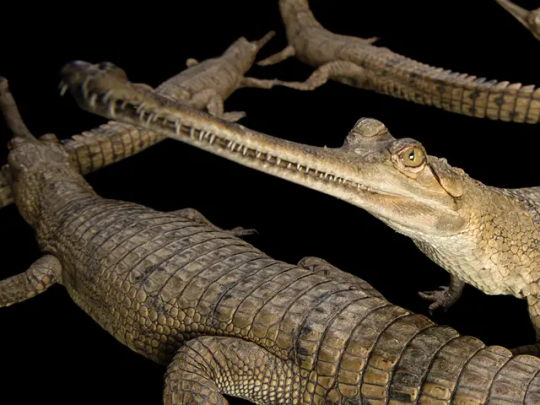
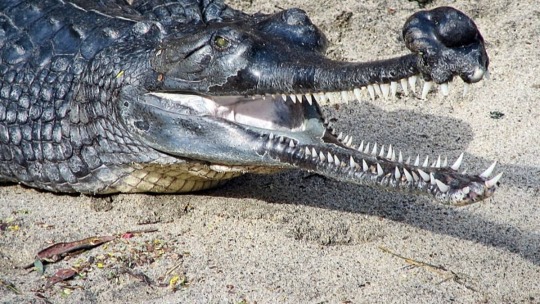
Black Caimans are also pretty interesting in my opinion and pretty easy to tell apart from other species once you pay attention to their colour. They are primarily a deep dark black of course, but what sets them apart from spectacled and other caimans is that very fine pattern of thin white stripes across the flanks that creates this beautiful contrast. They can also have patches of brown like the one on the right.
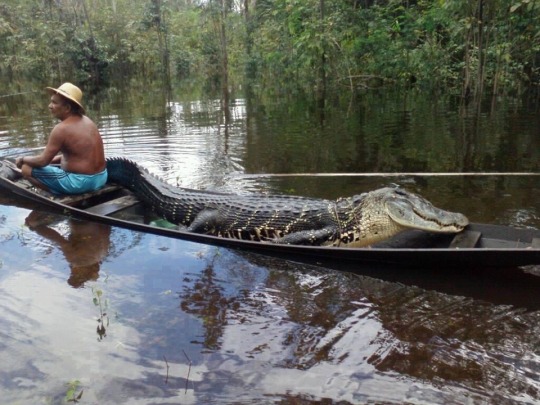

Orinocos also vary a great deal. Tho I know less about them than I wish I did, I know that individuals can range from drab brownish greys to yellow to somewhat earthy browns that almost range into reds.


The next ones a bit of an outlier. There are specific cave dwelling dwarf crocodile populations in western Africa with striking orange colouration. Tho this one is not exactly natural pigmentation to my knowledge and instead the result of the chemicals present in the water they inhabit, brought there by bat guano. Still very pretty animals.
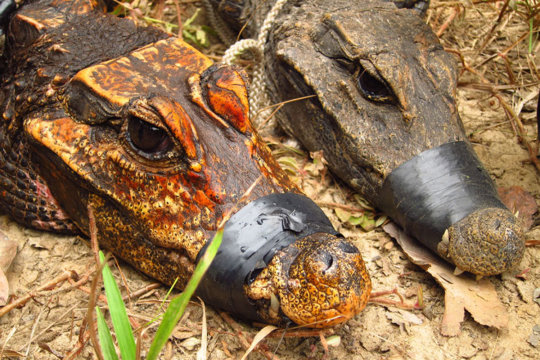
And then there's Paleosuchus, the dwarf caiman which contains two species. Again highly varied. The first image, which I believe is a Schneider's dwarf caiman, shows a very earthy brown. The others, which unless I'm mistaken are Cuvier's dwarf caimans, show colours ranging from dark with a rusty head, black to this still beautifully patterned individual. Of course these variations are also subject to change with age.
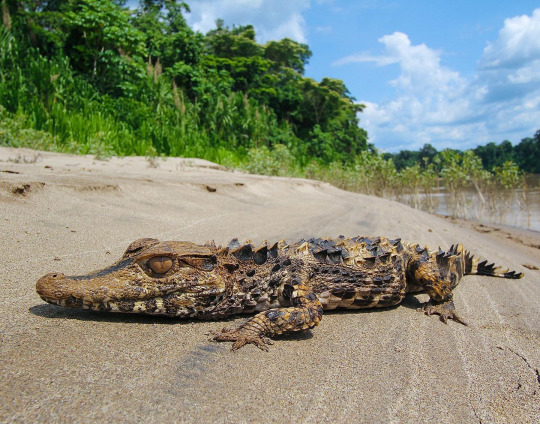
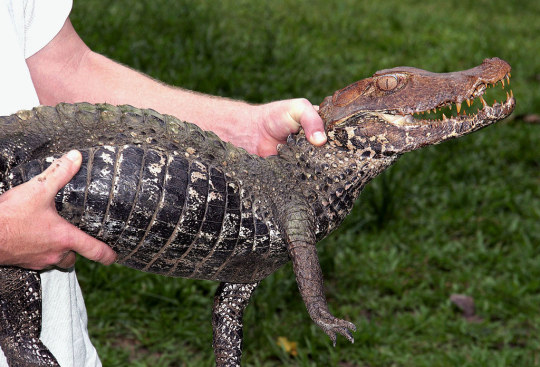
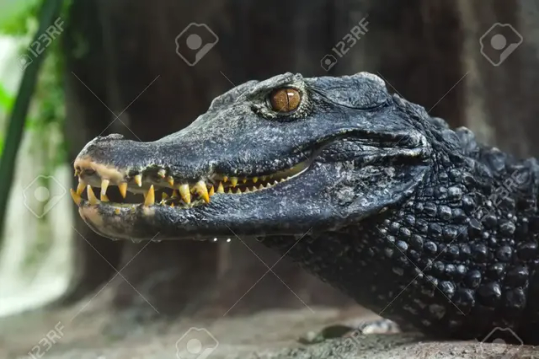
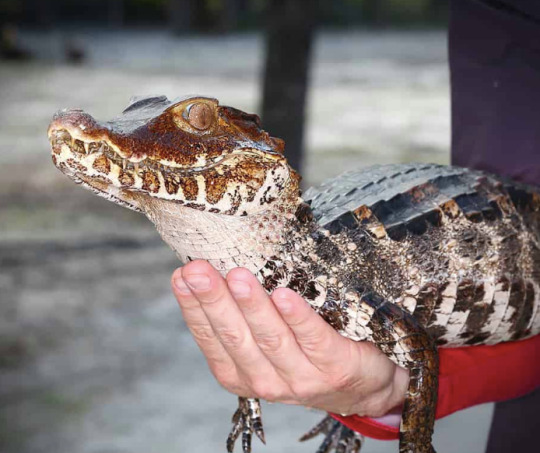
While salties aren't exactly known to be the most vibrant, I'd be remissed if I didn't mention this specific one. It's kept in a zoo in Germany and has this almost bizarre colour combination of creamy white underbelly and chocolate brown top which I've never seen in another saltwater crocodile. Photos by my friends Markus Bühler from the Bestiarium blog and René Dederich

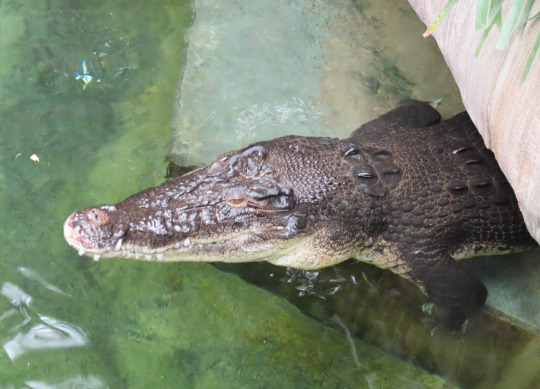

Spectacled, Broad-snouted and Yacare caimans I'll give a quick shout out. I think most people are familiar enough with how they look like and while their colours aren't anything special, I still think one should appreciate their patterns of spots and stripes and facial markings.

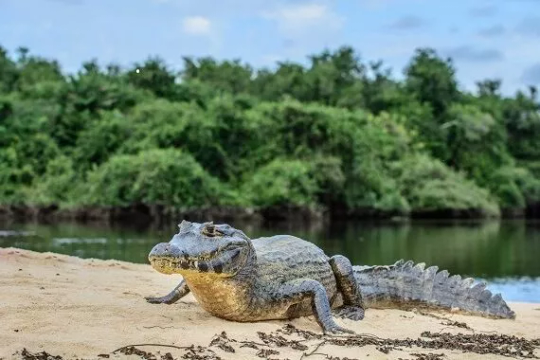
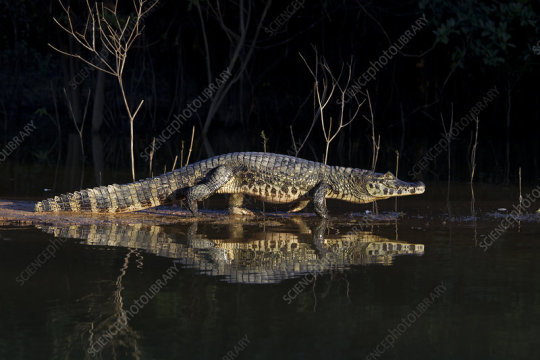
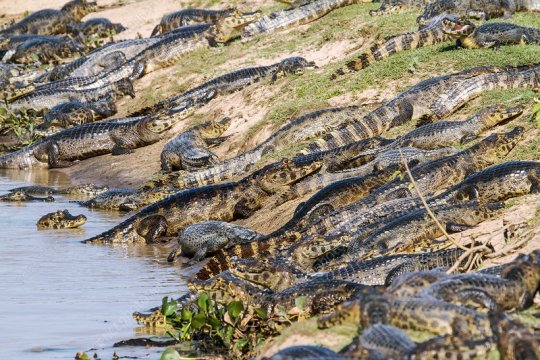
The last one I wanna highlight is the false gharial, Tomistoma, another one of my favourites. Part of the reason why being its at times beautiful reddish-brown colours.
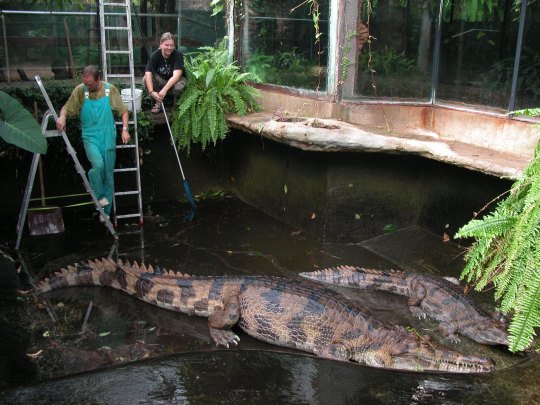
#crocodiles#crocs#gharial#gator#alligator#crocodilian#herpetology#reference#colours#inspiration#paleoart inspiration
2K notes
·
View notes
Photo










Bronx Zoo, New York City (No. 47)
The false gharial (Tomistoma schlegelii), also known as the Malayan gharial and the Sunda gharial, is a freshwater crocodilian in the family Gavialidae. It is native to Peninsular Malaysia, Borneo, Sumatra, and Java. It is listed as Vulnerable on the IUCN Red List, as the global population is estimated at around 2,500 to 10,000 mature individuals.
The specific name schlegelii honors German herpetologist Hermann Schlegel.
Unlike the gharial, the false gharial's snout broadens considerably towards the base and so is more similar to those of true crocodiles than the gharial, whose osteology indicates a distinct lineage from all other living crocodilians. However, preliminary nuclear genetic sequences may indicate the gharial and false gharial had a shared ancestor at some point in prehistory. Other molecular studies have similarly indicated that it is the nearest relative (the sister taxon) of the gharial.[6] Along with close fossil relatives, such as Maroccosuchus, it is thus increasingly classed in the family Gavialidae.
The false gharial is dark reddish-brown above with dark brown or black spots and cross-bands on the back and tail. Ventrals are grayish-white, with some lateral dark mottling. Juveniles are mottled with black on the sides of the jaws, body, and tail. The smooth and unornamented snout is extremely long and slender, parallel sided, with a length of 3.0 to 3.5 times the width at the base. All teeth are long and needle-like, interlocking on the insides of the jaws, and are individually socketed. The dorsal scales are broad at midbody and extend onto the sides of the body. The digits are webbed at the base. Integumentary sensory organs are present on the head and body scalation. Scales behind the head are frequently a slightly enlarged single pair. Some individuals bear a number of adjoining small keeled scales. Scalation is divided medially by soft granular skin. Three transverse rows of two enlarged nuchal scales are continuous with the dorsal scales, which consist of 22 transverse rows of six to eight scales, are broad at midbody and extend onto the sides of the body. Nuchal and dorsal rows equals a total of 22 to 23 rows. It has 18 double-crested caudal whorls and 17 single-crested caudal whorls. The flanks have one or two longitudinal rows of six to eight very enlarged scales on each side.
The false gharial has one of the slimmest snouts of any living crocodilian, perhaps comparable to the slender-snouted crocodile and the freshwater crocodile in the extent of slenderness, only that of the gharial is noticeably more slim. The false gharial is a large crocodilian. Males can reportedly grow up to 5 m (16 ft) in length. Three mature males kept in captivity measured 3.6 to 3.9 m (11 ft 10 in to 12 ft 10 in) and weighed 190 to 210 kg (420 to 460 lb), while a female measured 3.27 m (10 ft 9 in) and weighed 93 kg (205 lb). Females have been recorded at lengths of up to 4 m (13 ft 1 in). The false gharial apparently has the largest skull of any extant crocodilian, undoubtedly aided by the great length of the slender snout. Out of the eight longest crocodilian skulls from existing species that could be found in museums around the world, six of these belonged to false gharials. The longest crocodilian skull belonging to an extant species was of this species and measured 84 cm (33 in) in length, with a mandibular length of 104 cm (41 in). Most of the owners of these enormous skulls surprisingly had no confirmed (or even anecdotal) total measurements, but based on the known skull-to-total length ratio for the species, they would measure approximately 5.5 to 6.1 m (18 ft 1 in to 20 ft 0 in) in length.
False gharials are native to Peninsular Malaysia, Sarawak, and Indonesia (Sumatra, and Borneo), but were extirpated in Singapore and Thailand. It is unclear if they remain in Java. Apart from rivers, they inhabit swamps and lakes. The species is almost entirely found today in peat swamps and lowland swamp forests. In the 1990s, information and sightings were available from 39 localities in 10 different river drainages, along with the remote river systems of Borneo.
Prior to the 1950s, Tomistoma occurred in freshwater ecosystems along the entire length of Sumatra east of the Barisan Mountains. The current distribution in eastern Sumatra has been reduced by 30-40% due to hunting, logging, fires, and agriculture.
Source: Wikipedia
#World of Reptiles#Bronx Zoo#my favorite zoo#summer 2018#New York City#USA#original photography#reptile#funny animals#water#indoors#travel#tourist attraction#Wildlife Conservation Society#WCS#crocodile#Sunda gharial#flora#fauna#snout#close up#detail#head#Northeastern USA#vacation#animal#in the water
19 notes
·
View notes
Note
Hi Lauren I love your form finding analyses! Would you mind helping me find my form as well? I don't know what info is most pertinent, but I'm a type 1, istj, slytherin, and capricorn lol. thank you!
ope i’m so sorry about the lateness, i had this sitting in my drafts for quite a bit! but yes lots of thoughts!! the istj 1 evokes a very specific type of person... how appropriate that you’re also a capricorn. :)
the first species that comes to my mind are leopardus cats: wild cats within the leopard family. i was particularly looking at the ocelot, margay, oncilla, and andean mountain cat. these leopardus species are all going to be strongly private, perceptive, and ambitious. like all big cats, they’re confident individuals and are typically rather detached or removed from others. they’re not socially tolerant and are likely rather guarded around and suspicious of others; very slow to trust, self-focused, and individualistic.
the ocelot is going to be the most assertive of these species; not necessarily conflict-seeking, but just someone who is authoritarian, my way or the high way, and can be rather overbearing. they'll be defensive and argumentative when push comes to shove; they're people who are judgmental with high standards, and don't often yield on their sense of perfection.
the margay is more passive, someone who prefers to be private and cautious and stay out of the spotlight. likely more manipulative in that regard. highly specialized and don't do well with change, less overall confident than the ocelot and likes to find a niche. the oncilla is a similar species to the margay, though is more adaptable and bold, focused on efficiency, and is willing to be communicative. the andean cat is a wed of the two... someone who is highly specialized and sensitive to change, though more willing to be bold and assertive than the margay. i can see them being very stubborn and focused, and overall rather hardy and enduring people within their niche.
lots of birds would fit this type as well, especially birds of prey like the hawk and buzzard in the buteo genus. all of these species are going to be independent and incredibly efficient and proactive. they likely have a very detached but assertive demeanor and are very ambitious and opportunistic in their work... while also being extremely patient and perceptive people who plan ahead. they’re typically very loyal once someone has earned their trust and can be protective people, which is a huge difference from the leopardus. some examples here are: - the zone-tailed hawk (stoic, logical, adaptable, focused, highly loyal, competitive, controlling, perfectionistic, capable of being manipulative, opportunistic) - red-tailed hawk (confident, very assertive and argumentative, proud, expressive, stubborn, competitive, efficient, like consistency, but can be adaptable, selectively cooperative) - galapagos hawk (very socially tolerant, devoted, loyal, protective, cooperative, specialized, confident and bold, but generally more peace-seeking) - swainson’s hawk (socially tolerant and highly cooperative, less perfectionistic and much more adaptable, generalists, productive, protective and assertive, efficient) - rough-legged buzzard (socially tolerant, habitual, boundary-keeping and assertive, willing to be cooperative, can be manipulative, expressive, confident, perfectionistic)
the secretary bird also has strong 1 inclinations. to summarize what i discussed about them previously... they’re pretty socially flexible, confident, and selectively loyal. proud with high standards. someone who's assertive and stubborn, and tends to be more direct and judgmental. they’re hardy and have no issues adapting to change. i’d expect a pretty thick line between loved ones and acquaintances/strangers for these guys — they’re very ambivalent about those outside of their circle. even though i’d consider them loyal, they’re not the best at showing emotional attachment. they can act aloof and be a little self-centered.
outside of birds of prey, also check out the loon or swan, both wonderful water birds. loon species are going to be socially ambivalent, highly specialized, competitive, enduring and determined, direct, and individualistic and decisive. the swan is less ambivalent and extremely firm, stubborn, self-assured, argumentative, and determined, though at the same time they're really seeking meaning in their life and easily grow attached to people, places, and routines. however to the common person they're very independent and inflexible. i can go into more detail about specific species with these guys if you’d like.
steering away from bird, the elephant shrew. they're independent and emotionally/socially detached like the leopardus species as well as pretty private and guarded. however they're very much busy bodies and love to stay active. they're habitual and get anxious outside of their comfort zone and want to plan ahead and be cautious. very persistent, obsessive, and proactive people, but tend to be more anxious and self-preserving than the species mentioned so far. a completely different animal but a similar form in terms of size is also the kangaroo rat. they're more socially selective but also busy bodies who like being active and tend to be very thorough, hardworking people. they're big problem solvers and love to investigate things. they plan ahead and are equally as cautious, but much more willing to be assertive and manipulative, as well as communicative before it gets to that point. and very stubborn.
and finally check out reptiles! the gharial or false gharial i think are a lot like you. the gharial is going to be introverted but socially flexible, communicative, and loose-bonding. very very focused, dedicated, and hard-working people. specialized and particular, not the type to dabble. confident without being braggarts, and while they're normally rather withdrawn and passive people, they can assert themselves when needed. the false gharial is less focused and more of a dabbler and a generalist. like to have their fingers in all pots to ensure they can pursue the best result possible. still tend to be routine-keeping and particular, just with more of a mind to not put all of their eggs into one basket and capable of being adaptable.
hope this helps! :)
10 notes
·
View notes
Text
Slender-Snouted Crocodile
#FaunaFocus Little is known about the specific courtship and mating systems of slender-snouted crocodiles, but they are generally known to engage in sex-specific mating rituals in the water. #slendersnoutedcrocodile #crocodile #crocodiles
Little is known about the specific courtship and mating systems of slender-snouted crocodiles, but they are generally known to engage in sex-specific mating rituals in the water.
Little is known about the specific courtship and mating systems of slender-snouted crocodiles.
In general, crocodilians engage in mating rituals that include sex-specific interactions, performing visual displays to…
View On WordPress
0 notes
Text
Today I finally got to cross another crocodilian off my list, specifically Mecistops cataphractus. This is because one, Leila, originally owned by a Swiss author, has moved in to replace the enormous false gharial Adam at the Haus des Meeres in Vienna.
I stopped by twice today and though during my first visit of the day she was just lazily resting in a corner of her pool, the second time around I got lucky enough to see her swimm around a bit. Despite a length of "only" 2.7 meters she's quite the impressive sight none the less.
I also managed to get a still image from just before I left when she settled in one of the shallower parts of her pool, nicely showing how dark her scales are. To my knowledge she is the fourth crocodilian species kept at the aquarium.
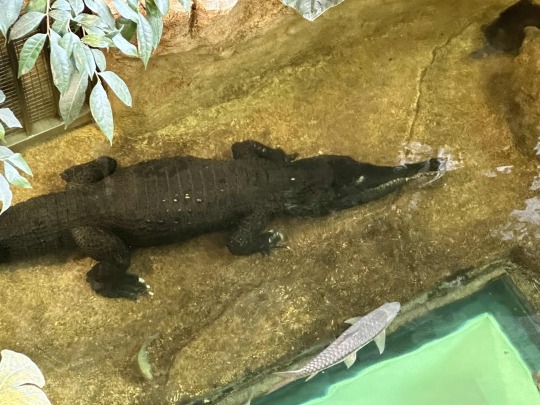
#mecistops#mecistops cataphractus#slender-snouted crocodile#crocodilia#west african slender-snouted crocodile#crocodile#haus des meeres#vienna
48 notes
·
View notes